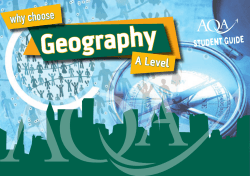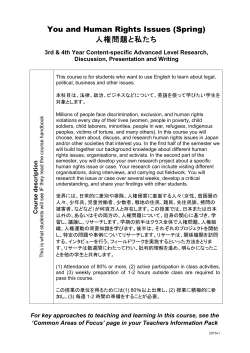
Gibberagong EEC Excursion Worksheet
A Study of The Mangrove Ecosystem Stage 6 Biology Fieldwork Journal Name: Class: Group Name/Number: Fieldwork Journal page 1 Introduction Bobbin Head is located in the Ku-ring-gai Chase National at the junction of the Cockle and Cowan Creeks. The park is mostly used by local residents for recreational activities including picnicking, fishing, bushwalking and bike riding. Facilities at Bobbin Head include a marina, picnic areas and a lunch-time restaurant in what used to be the Bobbin Head Inn, which also contains a National Parks information centre. The area also contains many bushwalking tracks and has sites of Aboriginal cultural significance including axe grinding grooves, engravings and midden caves. The Study Sites At the southern end of Bobbin Head is the Mangrove Boardwalk, a purpose built walkway that cuts through the mangrove ecosystem as part of the longer Gibberagong walking track. Bobbin Head Picnic Grounds Gibberagong EEC Marina Empire Marina Study site 1 Study site 2 What are some of the potential human impacts on the mangroves as indicated on this map Fieldwork Journal page 2 Other plant species of the Mangrove Ecosystem Common Name River Mangrove Scientific Name Aegiceras corniculatum A shrub - usually up to 2m in height. Generally found on the landward fringes of mangrove forests. The glossy green leaves are alternate. Common Name Swamp Oak Scientific Name Casuarina glauca A tree - usually up to 20m in height Generally found in dense strands in belts just inland from mangroves Branchlets: 30-50cm long, 1-2mm diameter Common Name Saltwater Couch Scientific Name Sporobolus virginicus A grass that grows occurs in clumps. Generally found in salt marshes and on sand-dunes Leaves are short, with stems about 1mm wide Source: www.dse.vic.gov.au/ Common Name Sea Rush Scientific Name Juncus kraussii Large, rigid, clumping forming perennial to 120 cm tall with an extensive rhizome system. Leaves and flower stems are tough, have pithy centres and taper to sharp points. Flower-heads are generally many branched with clusters of flowers towards their ends. Source: www.dse.vic.gov.au/ Common Name Sea Blite Scientific Name Suaeda australis Herb low dense spreading, sometimes a Shrub 10-30 cm, Shrub to 60 cm. Tidal Wetlands, salt flats, Drier, well drained, midlower tidal zone. Source: www.noosanativeplants.com.au/ Common Name Creeping Brookweed Scientific Name Samolus repens Samolus repens has small white or occasionally pink flowers with a flowering period from September through to March or April Source: http://www.chah.gov.au/ Fieldwork Journal page 3 Other animal species of the Mangrove Ecosystem Common Name Sand Whiting Scientific Name Sillago ciliata Sand Whiting are silvery white in colour with plain yellowish sides. Sand whiting feed on marine invertebrates including crustaceans (yabbies, prawns and soldier crabs) Source: www.shorefishingaustralia.com.au/ Common Name White-faced Heron Scientific Name Egretta novaehollandiae Mostly blue-grey in colour with a white face, Whitefaced Herons have a long thin neck, pointed greyblack bill and long legs. They feed on a variety of prey including insects, amphibians and fish Source: http://birdsinbackyards.net/ Common Name Sydney Rock Oyster Scientific Name Saccostrea glomerata They have a thick shell with a smooth exterier surface and are usually found in the intertidal zone to 3 metres below the low water mark. They are filter feeders, straining planktonic algae from the water. They are prey to a variety of fish. Common Name Tarwhine Scientific Name Rhabdosargus sarba The Tarwhine can be recognised by its silver body with rows of yellow spots forming stripes. It grows to 45 cm and weights up to 1.4 kg. Their main diet consists of prawns, worms and small crustaceans. Common Name Shrimp Scientific Name Shrimp are small animals that live on the floor of oceans and lakes. Shrimp are invertebrates (animals lacking a backbone) that have a tough exoskeleton. Shrimp are omnivores; they eat plants and small animals Source: www.sea-ex.com/fishphotos/oyster,.htm Fieldwork Journal page 4 Identifying Two Species of Mangroves Write down at least 7 observable differences between the two mangrove species. Be sure to look at height, leaves, flowers, fruit. Plant Adaptations Plant Common Name Grey Mangrove Scientific Name Avicennia marina Diagram Adaptations Draw a labelled diagram (include height, a leaf and fruit) Describe three adaptations 1. 2. 3. Word bank: pneumatophores, viviparous, excretion, exclusion Fieldwork Journal page 5 Identifying Two Species of Crabs Crab 1 Common Name Diagram Draw a labelled diagram of one of the crabs Animal Adaptations Adaptations Describe three adaptations of the crab 1. 2. 3. Word bank: Crab 2 Common Name Fieldwork Journal page 6 Measuring Distribution and Abundance of Adult Crabs Across the Intertidal Zone and Relating This to the Abiotic Factors Observation: At what site (1,2,3 or 4) do you believe most of the adult crabs are located? ________________________________________________________________________________ Hypothesis: Make a statement concerning what abiotic factors may affect the distribution of adult crabs. ________________________________________________________________________________ Task: To measure the distribution and abundance of adult crabs across the intertidal zone and relate these to the abiotic factors of the environment. Procedure: 1. Identify the four study sites as pictured below. 2. Randomly place a one metre quadrat in the first study site. Count the number of adult crab holes in the quadrat (an adult crab hole is larger than 1cm diameter) 3. Record your data in the table on the following page. 4. Use the procedures as outlined to measure the abiotic factors at this site. 5. Record your data in the table. Diagram 1: Profile of a Typical Mangrove Ecosystem showing study sites 2 4 1 3 Results: Complete your results on the next page Data Analysis and Discussion: Fieldwork Journal page 7 Results a. Abundance of crabs across the intertidal zone Group Site 1 Site 2 Site 3 Site 4 Site 1 Site 2 Site 3 Site 4 Totals Average (Total/no. groups) b. Abiotic Factors Across the Intertidal Zone Parameter Soil Moisture 0-10 (10 is very wet, 0 is very dry) Instrument: none Air Temperature (0C) Instrument: thermometer or Kestrel Humidity 1m above ground (%) Instrument: hygrometer or Kestrel Wind Speed Instrument: anemometer or Kestrel Light Intensity 1m above ground Instrument: light meter Soil Temperature 10cm below Instrument: soil thermometer Interpretation Fieldwork Journal page 8 Relating Abiotic Factors to the Distribution of Plants Across the Intertidal Zone Hypothesis: Make a statement concerning the distribution of one of the plants ____________________________________________________________________________________________________________________________ Task: To measure the abundance and distribution of plants across the intertidal zone and and relate this to the abiotic factors measured Procedure: 1. Lay out a straight transect line of 30m through the vegetation from either the landward or shoreward edge of the intertidal zone 2. Using a builders string and spirit level, prepare a level string above the tape measure 3. Undertake a belt transect, placing the 1m2 quadrat at one metre intervals along the transect 4. Count the total number of each plant listed below within each of the quadrats and complete the table on the next page (abundance and distribution) 5. Within the centre of each quadrat, measure and record each of the abiotic factors and complete the table on the following page (abiotic factors) 6. Complete your data analysis and discussion below. Results: Complete your results on the next page Data Analysis and Discussion: Discuss your results with regards to your hypothesis Fieldwork Journal page 9 Results a. Plant Abundance and Distribution Across the Intertidal Zone Plant species 0-1m 2-3m 4-5m 6-7m 8-9m 1011m 1213m 1415m 1617m 1819m 2021m 2223m 2425m 2627m 2829m 3031m Q1 Q2 Q3 Q4 Q5 Q6 Q7 Q8 Q9 Q10 Q11 Q12 Q13 Q14 Q15 Q16 Grey Mangrove River Mangrove Casuarina Juncus Sea Blite Saltwater Couch b. Abiotic Factors Across the Intertidal Zone Parameter Elevation (cm) Air Temperature 1m above ground (oC) Soil Temperature 10cm below ground (oC) Humidity 1m above ground Soil Moisture (10 is very wet, 0 is very dry) 0-1m 2-3m 4-5m 6-7m 8-9m 1011m 1213m 1415m 1617m 1819m 2021m 2223m 2425m 2627m 2829m 3031m Q1 Q2 Q3 Q4 Q5 Q6 Q7 Q8 Q9 Q10 Q11 Q12 Q13 Q14 Q15 Q16 Total No. Average No. Total/ No. Quad Fieldwork Journal page 10 Results c. Cross-section results (Optional) Plant Key Key Topography (cm) Swamp Oak Grey Mangrove River Mangrove Saltwater Couch Sea Rush wwww Sea Blite Creeping Brookweed ooooo Unknown iiiiiiiiiiiiiiiiiiii xxxx Height below cm 0 String line 20 40 60 80 100 0-1m 2-3m 4-5m 6-7m 8-9m 10- 11m 12- 13m 14- 15m 16- 17m 18- 19m 20- 21m 22- 23m 24- 25m 26- 27m 28- 29m 30- 31m Fieldwork Journal page 11 Interactions Between Organisms in Mangrove Environments 1. Beneficial and Detrimental Relationships Name interacting organisms and briefly describe the nature of the interactions Gain Mutualism Mutualism 1: Algae Loss Gain Loss Gain Loss Parasite: produces food Mutualism 2: Commensalism Parasitism Host: Gain Loss Allelopathy Commensal: Allelopath: Host: Competitor: Fieldwork Journal page 12 2. Trophic Interactions Use the diagram opposite and observations from today to complete the following observation table and food chains to show energy flow using organisms in this ecosystem. Include the trophic level. The trophic levels are producer, primary consumer (herbivore), secondary consumer (carnivore), tertiary consumer (large carnivore) or decomposer. Name Food Food Chain Food Chain Sun Sun Trophic Level Mangrove Producer ______________ ______________ ______________ ______________ ______________ ______________ Fieldwork Journal page 13 http://www.daff.qld.gov.au/fisheries/habitats/marine-plants-including-mangroves/dead-marine-wood http://www.environment.nsw.gov.au/resources/waterwatch/estuaryGuideStudents/20100686EstuaryFactWorksheets.pdf
© Copyright 2025














